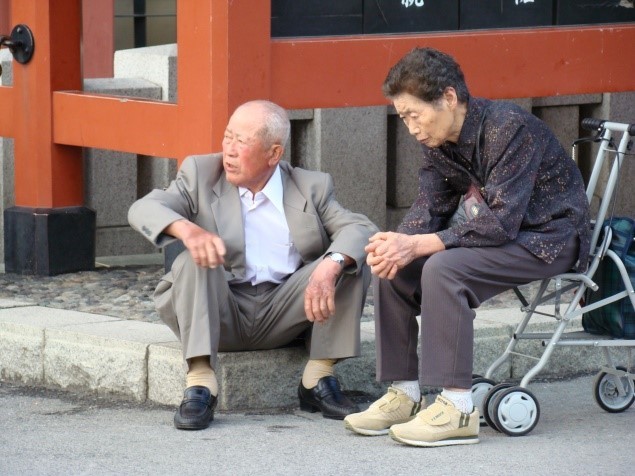· Os fatores que levaram à redução da população
A população japonesa em 2009 atingiu seu maior número de habitantes. Chegou a 127.340.884 milhões; desde então este número vem decrescendo. Decorridos apenas dez anos, 2019 já apresenta uma queda populacional de aproximadamente 2 milhões de pessoas. Isto causa um grande impacto na economia e na sociedade como um todo, devido à redução da população economicamente ativa e a consequente redução da mão-de-obra, e ao aumento da população idosa.
O ex-ministro da saúde, Katsunobu Kato, anunciou que em 2017 nasceram apenas 946.060 crianças, o menor número registrado desde 1899. Em contrapartida, 1.340.433 japoneses faleceram. O escritório de estatísticas do Japão estima que a população diminuirá para 100 milhões, em 2050, e para apenas 85 milhões, em 2100, ou seja, uma redução populacional de 40 milhões dos dias atuais.

Inúmeros fatores resultam neste declínio populacional. Entre eles, o mais conhecido é a conhecida narrativa da mídia sobre a “síndrome do celibato” (em japonês “sekkusu shinai shokogun”). Segundo ela, os jovens não estão interessados em relações sexuais. Um estudo realizado pelo “Instituto Nacional de Pesquisa sobre a População e Seguridade Social”, realizada em junho de 2015, apontou que dos jovens na faixa etária entre 18 e 30 anos, 42% dos homens e 44% das mulheres são virgens. Aproximadamente um terço dos japoneses está entrando na casa dos 30 anos sem nenhuma experiência sexual.
Entre os vários motivos, eles consideram assustadoras as interações com o sexo oposto e acham mais simples consumir pornografia, recorrer a robôs sexuais e até às realidades virtuais, que são de fácil acesso. Diminuiram igualmente as relações sexuais dentro dos casamentos: em 2017 uma pesquisa apontou que 47,2% dos casados não praticava sexo há um mês. O aumento da prostituição e sua facilidade de acesso são outros fatores que contribuíram para o declínio demográfico, já que não é mais necessário criar relações afetivas para satisfazer os desejos sexuais.

Foto: Fausto Godoy
Segundo Anne Allison, professora de cultura e antropologia na Universidade de Duke, apesar dos fatores anteriormente mencionados serem relevantes, o principal motivo para que as taxas de nascimentos no Japão sejam baixas é a insegurança econômica. Em um país onde culturalmente ainda se espera que o homem seja o provedor do lar, sustentando a família financeiramente e garantindo as melhores condições de vida, a falta de empregos estáveis está criando uma classe de homens que não se casam e não geram filhos por não se sentirem capazes de sustentá-los. Já as mulheres, na cultura japonesa, possuem um papel mais familiar e delicado, dedicado a cuidar da prole, tanto que é muito comum que após o primeiro filho as mulheres abandonarem os empregos para cuidar do lar.
Isto surpreende, pois, o Japão é um país onde a taxa de desemprego é de apenas 2,4%. Nos anos pós-guerra o Japão possuía uma tradição de empregos estáveis, onde os homens iniciavam suas carreiras em uma empresa tinham garantidos bons benefícios, aumentos salariais, e havia o entendimento de que através do trabalho árduo conseguiriam manter seu emprego até a aposentadoria. Entretanto, com a globalização este cenário se modificou, com a introdução do princípio do reconhecimento ao mérito no seio da empresa. O empresário Carlos Ghosn, responsável pela recuperação da Nissan, em 1999, e CEO da aliança Renault-Nissan, em 2005, foi o introdutor desta fórmula, que modificou vários conceitos anteriormente considerados inabaláveis.

Foto: Fausto Godoy
Segundo pesquisas da Temple University referentes aos tipos de empregos e número de empregados no Japão, cerca de 40% desses empregos são “irregulares”, o que significa que esses trabalhadores não ocupam funções estáveis, eles recebem salários baixos e não possuem benefícios; não obstante, são computados como empregados nas estatísticas do governo. Apenas 20% desses trabalhadores “irregulares” consegue vagas de empregos melhores em algum momento de suas carreiras. O número de trabalhadores estáveis diminuiu em 3,8 milhões, enquanto o número de “irregulares” aumentou em 7,6 milhões. Esses desempregados, devido ao profundo sentido de honra que subjaz na cultura japonesa, escondem sua condição e muito perambulam pelos parques de cidades, como Tóquio trajando roupa social para “driblar” a censura de seus vizinhos, por exemplo. Entretanto, recebem um seguro-desemprego – shitsugyou hoken – cujo valor varia de acordo com o tempo de trabalho e o salário percebido anteriormente.
Desempregados no Japão (Fotos: Fausto Godoy)
É frequente que os empregos irregulares sejam ocupados por mulheres, o que também gera implicações para a constituição de uma família, já que os horários são imprevistos e os salários baixos. No entanto, o homem não possuir um bom emprego é um obstáculo ainda maior, já que cerca de 70% das mulheres param de trabalhar após terem o primeiro filho, por conta da estrutura social, dos costumes e dos valores japoneses.
Até mesmo homens com empregos desejáveis não estão sendo capazes de constituir família, já que para manter seus lugares eles precisam trabalhar longas jornadas e não possuem tempo para relacionarem-se com mulheres ou realizar qualquer atividade além do trabalho.
O declínio populacional fará com que o mercado de emprego perca muita mão-de-obra futuramente. No entanto, este fenômeno está abrindo espaço para o desenvolvimento de uma área já conhecida no Japão: a robótica.
· A Robótica
Os robôs sempre foram vistos de uma ótica positiva no Japão. Alguns estudos ocidentais atribuem tal fenômeno à religião xintoísta, para a qual os objetos possuem espírito; isto faz com que os japoneses convivam em harmonia com a ideia dos robôs, já que para eles é mais fácil aceitá-los como seres e tratá-los com respeito. Influências culturais também geraram consequências na aceitação desta tecnologia, como o teatro, os animes e mangás, que introduziram a cultura do robô no dia a dia da população.
Em1924 já existiam até mesmo peças de teatros sobre o tema. A mais popular delas foi Jinzo Ningen (Humano Artificial), do roteirista tcheco Karel Capek – R.U.R. Os mangás também tiveram um impacto muito forte na área da robótica, pois neles os robôs são muitas vezes representados como amigos; foi desta forma que muitas gerações de japoneses, após 1950, desenvolveram conceitos positivos relacionados aos robôs, estabelecendo-se, assim uma relação amigável entre robôs e os humanos no Japão. Exemplos de sucesso são os famosos mangás Astro Boy e Mazinger Z,
O interesse dos japoneses pela robótica é antigo. Data do período Edo, entre 1603 a 1868, com as Karakuri Nyngyo, que são consideradas os primeiros robôs japoneses. Eram basicamente bonecas com cordas e engrenagens que movimentavam bandejas de chá, fingiam escrever kanjis e algumas até andavam. Entretanto, o primeiro robô humanoide foi o famoso Gakutensoku, criado em 1928, que era capaz de piscar os olhos e de mover sua caneta e seu cetro. No que respeita à inteligência artificial, Wabot 1 foi o primeiro; ele foi criado em 1973, em Tóquio. O Wabot 1 possuía um sistema de visão e comunicação. No final dos anos 90 foi criado o primeiro robô pet, que deu início à utilização terapêutica dos robôs.
Muitas empresas de robótica focaram o lado utilitário dos robôs para servirem de mão-de-obra. Em consequência, desde a década de 70 o país está na vanguarda da robótica industrial. Nessa época os robôs eram usados em fábricas de automóveis e equipamentos eletrônicos, “monozukuri”, com o objetivo de liberar os humanos das operações mais rigorosas. O uso dos robôs se difundiu e eles começaram a realizar trabalhos perigosos fisicamente, como o transporte e a montagem de peças pesadas. No ano de 2005 o Japão possuía mais de 370.000 robôs como mão-de-obra em suas fábricas.
Com o objetivo de repor a mão-de-obra cada dia mais envelhecida do Japão, o número de robôs de serviços cresceu atualmente: são os denominados “robôs sociais “. Eles possuem aparência semelhante à dos humanos e desempenham inúmeras funções, entre elas recepcionar as pessoas nos hotéis e hospitais. Já nas residências, os robôs domésticos são os mais comuns, como os cortadores de grama e aspiradores de pó. A aceitação da robótica e sua integração no dia a dia dos habitantes propiciou a criação de uma nova forma de sociedade, mais ágil e funcional.
· A Sociedade 5.0
Em 2017 o primeiro ministro do Japão, Shinzo Abe, apresentou no “Centrum der Büro und Informationstechnik/” CeBit, o mais célebre fórum mundial de tecnologia e de tecnologia da informação e comunicação, o novo conceito da sociedade japonesa, a sociedade 5.0; ela consiste na integração da tecnologia às tarefas do cotidiano. Este título deveu-se ao fato de que este seria o quinto estágio das sociedades: o primeiro foi o da caça e coleta; o segundo a etapa agrária, passando, depois, para a sociedade industrial – terceiro período – seguindo-se o quarto estágio, a sociedade da informação, para, finalmente, a “smart”, que é a conectada e integrada.

O Japão foi pioneiro nesta nova forma de sociedade, pois possui a estrutura e os mecanismos sociais para sustentá-la: sempre teve interesse pela área da robótica. E resiste a aceitar imigrantes para repor o decréscimo populacional. Sua estrutura civilizacional agrega a sociedade e afasta o “estrangeiro”: é a “síndrome da ilha”, que une a população. Este novo modelo de sociedade funcionaria da seguinte maneira: o maior número de informações seria carregado para uma grande base de dados. Esta privilegiaria quatro grandes áreas: saúde, mobilidade, infraestrutura e tecnologia financeira (fintech).
Na esfera da saúde, o principal problema enfrentado pelo sistema são os encargos decorrentes do processo de envelhecimento acelerado da população, dos altos custos dos convênios médicos e dos gastos com os idosos. A solução buscada através do sistema conectado será o compartilhamento das informações médicas e o atendimento em lugares remotos, aumentando a independência do paciente, que poderá ser atendido em sua residência, reduzindo a ida frequente aos hospitais e os custos com despesas médicas.
No âmbito da mobilidade e das redes de transporte, o fenômeno da “despopulação” no Japão dá origem a um problema ainda mais agudo nas zonas rurais, uma vez que muitas pessoas preferem habitar as áreas urbanas em busca de melhores empregos. Muitos habitantes não possuem acesso aos meios de transporte, o dificulta a ida às compras ou até mesmo aos hospitais. Esta falta de acessibilidade prejudica o comércio. Em contrapartida, o e-commerce vem-se beneficiando e se expandindo, pois encomendas realizadas online serão enviadas por meio de drones. Para solucionar, de outra forma esses problemas de locomoção, veículos autônomos de ônibus e táxi serão utilizados para o transporte, propiciando a melhora do planejamento logístico e uma locomoção mais ágil e eficiente, que pode ser monitorada por controle remoto.
Na área de infraestrutura, os sensores, a inteligência artificial e os robôs serão empregados maciçamente nessa sociedade integrada. A tecnologia será utilizada para monitorar e inspecionar as construções de pontes, túneis, estradas e barragens, por exemplo, já que as condições climáticas no Japão são extremas. Da mesma forma, através deste controle, os desastres poderão ser evitados, incrementando a segurança e a produtividade.
Por último, cabe mencionar o setor de Fintech, termo utilizado para simbolizar a união de duas palavras, financeiro e tecnológico. No Japão muitas transações ainda são realizadas por papel moeda, o que torna lentas as operações. A sociedade 5.0 pretende implantar uma tecnologia de Blockchain, espécie de banco de dados em que ficam gravadas as transações de bitcoins. Ao utilizar criptomoedas, além de mais rápidas, as transações serão são mais seguras e inseridas no sistema internacional.
A união entre o histórico japonês de interesse na área de tecnologia e robótica, associada aos desafios demográficos, está viabilizando esta nova forma de sociedade – a sociedade 5.0 – na qual os problemas sociais são reduzidos, ou até mesmo solucionados graças à tecnologia. Entretanto, os robôs podem substituir o trabalho dos humanos, mas o objetivo não é que as máquinas tomem o lugar dos cidadãos japoneses: a finalidade é que ocorra uma integração entre a tecnologia e as atividades cotidianas das pessoas, tornando-as mais proveitosas e agradáveis.
Referências
ABENOMICS. Realizing Society 5.0. Disponível em: <https://www.japan.go.jp/abenomics/_userdata/abenomics/pdf/society_5.0.pdf>. Acesso em: 29 mar. 2019.
GRANRATH, Dr. Lorenz. Japan’s Society 5.0: Going Beyond Industry 4.0. Disponível em: <https://www.japanindustrynews.com/2017/08/japans-society-5-0-going-beyond-industry-4-0/>. Acesso em: 29 mar. 2019.
FOUCHÈRE, Arthur. Robôs de serviços evoluem no Japão. Disponível em: <https://diplomatique.org.br/robos-de-servicos-evoluem-no-japao/>. Acesso em: 04 abr. 2019.
IFR. Why Japan leads industrial robot production. Disponível em: <https://ifr.org/post/why-japan-leads-industrial-robot-production>. Acesso em: 03 abr. 2019.
Japan Business Federation. Toward realization of the new economy and society: Reform of the economy and society by the deepening of “Society 5.0”. April 19, 2016. Disponível em: <http://www.keidanren.or.jp/en/policy/2016/029_outline.pdf>. Acesso em: 29 mar. 2019.
POPULATIONPYRAMID. Population Pyramids of the World from 1950 to 2100. Disponível em: <https://www.populationpyramid.net/japan/2017/>. Acesso em: 29 mar. 2019.
OGLOBO. Japão tem número recorde de casamentos sem sexo. Disponível em: <https://oglobo.globo.com/sociedade/japao-tem-numero-recorde-de-casamentos-sem-sexo-20922252>. Acesso em: 03 abr. 2019.
ORTEGA, AndrÉs. Por que os japoneses amam os robôs? Disponível em: <https://brasil.elpais.com/brasil/2016/05/05/ciencia/1462469697_487807.html>. Acesso em: 04 abr. 2019.
SEMUELS, Alana. The Mystery of Why Japanese People Are Having So Few Babies: Many point to unromantic 20-somethings and women’s entry into the workforce, but an overlooked factor is the trouble young men have in finding steady, well-paid jobs.. JUL 20, 2017. Disponível em: <https://www.theatlantic.com/business/archive/2017/07/japan-mystery-low-birth-rate/534291/>. Acesso em: 29 mar. 2019.
SUNO. Carlos G. Disponível em: <https://www.sunoresearch.com.br/tudo-sobre/carlos-ghosn/>. Acesso em: 03 abr. 2019.
TABUCHI, Hiroko. Japanese robots enter daily life. Disponível em: <https://abcnews.go.com/Technology/story?id=4371176&page=1>. Acesso em: 03 abr. 2019.
THEREPORTCOMPANY. How students are being prepared for Society 5.0. Disponível em: <https://www.globaljapan.world/article/japan-leads-world-in-education-for-society-5-0/>. Acesso em: 29 mar. 2019.
HITACHI – UTOKYO LABORATORY. Realizing Society 5.0: through “Habitat Innovation”. Disponível em: <https://socialinnovation.economist.com/pdf/Realizing_Society_5.0_through_Habitat_Innovation_.pdf>. Acesso em: 29 mar. 2019.
HORNYAK, Tim. The face that launched a thousand robots. Disponível em: <https://www.japantimes.co.jp/life/2008/08/20/digital/the-face-that-launched-a-thousand-robots/#.XKJoNphKiM8>. Acesso em: 03 abr. 2019.
U-TOKYO. Japan: the Land of Rising Robotics. Disponível em: <https://www.u-tokyo.ac.jp/en/whyutokyo/wj_003.html>. Acesso em: 03 abr. 2019.
WILFORD, Ggreg. Young Japanese people are not having sex: Nearly a third of Japanese people are entering their 30s without any sexual experience, leaving the country facing a steep population decline. Disponível em: <https://www.independent.co.uk/news/world/asia/japan-sex-problem-demographic-time-bomb-birth-rates-sex-robots-fertility-crisis-virgins-romance-porn-a7831041.html>. Acesso em: 03 abr. 2019.
Carolina Hissano Tazima, londrinense, estudante de Relações Internacionais na ESPM-SP. É analista júnior no Núcleo de Estudos e Negócios Asiáticos. Nutre um grande interesse pelas diversas culturas, especialmente a asiática. Entusiasta das causas ambientais e dos direitos dos animais
